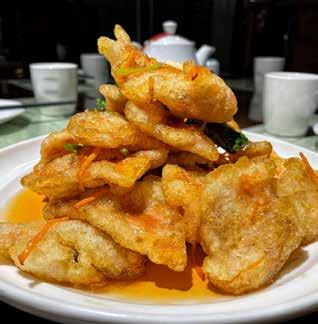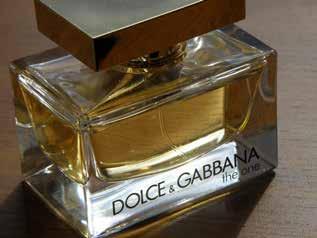
19 minute read
ESCAPE TO HARBIN
What to Do, See and Eat in Ice City
By Sophie Steiner
Advertisement
Felix Bernard’s Winter Wonderland truly comes to life in the capital of China’s Heilongjiang province, Harbin. Founded in 1898, the city has evolved from a small rural settlement on the Songhua River to one of the largest cities in Northeast China.
Harbin is blessed with dry, freezingcold winters, making it an ideal winter destination. This is largely thanks to the city’s annual ice festival; a two-monthlong extravaganza featuring giant lit-up ice sculptures. Now in its 37th edition, the 2021 Harbin International Ice and Snow Sculpture Festival kicked off on December 25, 2020 (with the official opening ceremony taking place on January 5, 2021), and runs to the end of February 2021.
One of the four largest ice festivals in the world, Harbin’s iteration is a must-see for the sheer spectacle alone, but there’s plenty more to the ‘Ice City’ than just ice. When in town for a visit, you can explore the Russian-influenced architecture while sipping locally brewed Harbin beer.
Spend an evening listening to China’s oldest symphony and then fill up on Dongbei dishes with a side of Russian flare. Stroll along the Zhongyang Pedestrian Street, visit a bookstore full of old world charm and a few cultural and history museums, check out a Russian-style theme park, go snowmobiling in a frozen tundra and round it all out with ice skating and tobogganing along the Songhua River.
Situated near the border of Russia, the strong Eastern European and Jewish influences are evident from the streets – which wind in typical meandering European fashion – to the table, where local Harbin-style smoked savory red sausage is more akin to the mild German-style than Chinese.
Aesthetically, the city boasts formidable historic architecture, ranging from temples, churches (including the famous Russian Orthodox Church of St. Sophia) and synagogues. These mark Harbin’s Daoli district, a popular tourist spot. Meanwhile, those looking for quieter and authentic Chinese culture can visit ‘Old Harbin’ in Daowai district.
Yet, there’s something undeniably modern about Harbin. Take a look at the sculptural Harbin Opera House and Grand Theater. Better – or at least higher – yet, hop on Harbin’s Ferris wheel for views of the whole city (just remember to bring your coat and an extra pair of gloves).
In the following pages, learn more to see, taste and do in the Ice City.


*Please note to travel with caution during the pandemic. We advise confirming ahead of time with your airline and hotel regarding required COVID-19 tests and the current status of the city. Always wear a mask and avoid crowds.
Looking for more expert guides to China’s biggest cities and hottest destinations? Purchase our Explore China travel guide, which offers insider tips, detailed city guides and more. You can scan the QR code below to order:
哈尔滨国际雪雕节
The glittering ice jewel in Harbin’s metaphorical ice crown, Harbin’s annual monthslong Ice and Snow Sculpture Festival is not to be missed. Attracting millions of visitors, both local and international, the festival comprises astounding ice sculpture exhibits that are jaw-dropping in both size and artistry.
Taking place across multiple venues, the festival has a different theme every year and is the largest of its kind globally, boasting the world’s biggest ice sculptures. Marvel at life-sized buildings and dreamy castles and enjoy the snow-sports on offer, like sledding and ice-skating. Be sure to visit at night – when you can view the structures lit up in multi-color by thousands of colorful LED lights fitted inside each sculpture.
Established in 1985, the festival’s exhibits are crafted by ice sculpture experts from all around the world. As such, the festival is not only an attractive wonderment but also an opportunity for cultural exchange. The three major venues are Sun Island, Ice and Snow World and Zhaolin Park.
Sun Island houses the Snow Sculpture Exposition and the world’s largest indoor ice and snow art museum. While the other two locations can be visited at night, Sun Island is a daytime spot. Entrance in 2021 is RMB100 per person.
Ice and Snow World was built in 1999 and is a massive ice architecture park. Its design was inspired by world-famous architecture, such as the pyramids of Egypt, as well as traditional Chinese tales. At night, all the structures are lit up with thousands of multicolored LED lights.
Ice and Snow World is the most impressive attraction and looks quite different during daytime and nighttime – so it’s worth going both times!
Last but not least, Zhaolin Park is a must-visit for its beautiful ice lanterns, which are made by carving and decorating piledup snow. A multitude of objects are carved from the ice, like European-style churches, gardens, fantastical creatures and waterfalls. The sculptures here are relatively smaller, which is why entrance is free. Also best viewed at night.
Since the festival takes place each year from the end of December through February, the weather is cold – scratch that, freezing – with temperatures ranging between -25 and -10 degrees Celsius – so it pays to bundle up. Thermals, a warm coat and wind jacket, thick boots, gloves, scarves, earflaps and a wooly hat are all par for the course.
Tickets must be purchased for each venue of the festival, with different prices for each location. Tickets for all three can either be purchased directly at the attraction or online; discounts and group packages are also available. During the festival, special buses run across the city, shepherding tourists to each venue. To save time getting around and for more privacy, try hiring a private driver.
Altogether, the ice festival ensures that Harbin is enveloped in a magical cloak of joy during the coldest months of the year. It’s a spectacle that must be seen up close to fully appreciate its magnificence.




Saint Sophia Cathedral 哈尔滨圣索菲亚教堂
Located in central Harbin along the Zhongyang Dajie Pedestrian Street, Saint Sophia Cathedral is a former Russian Orthodox Church and a prime example of Neo-Byzantine architecture in China. Founded in 1907, the cross-shaped cathedral stands at 53.3 meters tall and over 721 square meters in area. A striking green dome tops the main center hall, while four different tent roofs surround the center dome. After periods of expansion, closure and restoration, the church now serves as an art gallery, showcasing the city’s architectural development. A large musical fountain sits in front of the church, providing a pretty scene for photo opportunities. The church – hailed the largest Orthodox Church in the Far East – looks especially majestic at night. Hours: Daily, 8.30am-5pm Admission: RMB20 (ticket sales end at 4.30pm) Address: 88 Toulong Jie, Daoli district 道里区透 笼街88号
Songhua River 松花江

If you’re visiting Harbin for the Ice Festival, there are plenty of daytime activities to do such as ice skating on the Songhua River, which completely freezes over during the winter (NovemberApril). You can get to the riverside by walking from Central Street. There is also a cableway crossing the river that connects Tongjiang Square in Daoli district with Sun Island Park. Cableway Hours: 8.30am-6pm, ticket sales end at 5.30pm Admission: RMB50 one-way, RMB80 roundtrip Address: Songhua River Cableway (松花江观光索道), 218 Tongjiang Jie, Daoli district 道里区 通江街218号, (0451) 8468 8841
Zhongyang Dajie Pedestrian Street 中央大街
This picturesque 1.4-kilometer-long avenue is located in the old central district of Harbin. Built in 1898, it is a prime example of Baroque and Russian architecture. The store-lined cobblestone streets are a shopper’s dream, with stores including both international and local brands. Most businesses close by 10pm. Make sure to stop by Madieer (马迭尔冰棒) for a frozen popsicle, a major hit among visitors even in the frigid winter months! Address: Zhongyang Dajie (between Jingwei Jie and Stalin Park at the Songhua River), Daoli district 道里区中央大街

DONGBEI CUISINE
Located in the Dongbei region, it’s no surprise that Harbin has a variety of Dongbei restaurants. As a ‘gateway’ to Chinese cuisine, Dongbei food is most similar to Chinese food in North America – minimal spice, heavier on the meat, many fried dishes and a variety of pickled veggies. Our favorite Dongbei restaurants in Harbin include Lao Chujia (老厨家) and Dongfang Jiaozi Wang (东方饺子王) for dumplings.
Liangpi 凉皮
These ‘cold skin’ noodles can be found all around China, but the Harbin version has its own special twist. Clear and velvety soft, almost like jelly, the noodles are smothered in a thick sesame paste sauce. The dish is served with julienned cucumbers, carrots, tofu skin, cabbage, greens and chilis for a colorful vegetarian dish.



Boiled Dumplings 水饺
Almost every restaurant in the city offers dumplings of all varieties, the most famous of which are boiled. Fillings range from beef to pork and cabbage to mushroom and chicken to egg and spring onion. If you’re craving extra-crisp potstickers, they are usually available as well. Dumplings are best enjoyed dipped in a sauce made of dark vinegar, soy sauce, garlic and chili oil.

Guobaorou 锅包肉
For a not-so-vegetarian alternative, guobaorou, or sweet and sour pork, is another Dongbei classic. Sliced pork is breaded and fried before being smothered in a sticky sweet and sour sauce. Crispy and tangy, each bite is more enticing than the last.
Russian Cuisine
Harbin is chock-full of Russian restaurants featuring food from Mother Russia. Think bellinis with caviar, borscht, beef stroganoff and fruit pizza, to name a few. We suggest trying Russian food at Pectopan (金色时光西餐厅), Lucia ( 露西亚西餐厅), Madieer (马迭尔 餐厅) or Portman Western Style Restaurant (波特曼西餐厅), and we guarantee there will be no shortage of meat and potatoes – hearty food to keep you warm during the cold months.
Dalieba 大列巴
Also known as the ‘big bread,’ dalieba is a round sourdough loaf weighing up to 2.5 kilograms. Dalieba is savory in flavor, rather than sweet like most Chinese bread, with a crispy outer crust and fluffy inside. The bread’s origins can be traced back to Harbin’s historical ties with Russia, when it was a stop on the trans-Siberian railway and a former Russian trading post, as well as a haven for Russian immigrants during the Russian Revolution. This bread can be found at most restaurants and sold by street vendors along Zhongyang Pedestrian Street.
BUSINESS TECH &
Just Relx
The E-Cigarette Brand Vaporizing the Competition p36

Hot on Taobao P32 Highs and Lows P33
DR. SHIRLEY YU
Political Economist, Professor and Author

Interview by Ryan Gandolfo
A leading voice on China’s role in the global economy, Dr. Shirley Yu is highly sought after whenever China is making global headlines (which is often). With a PhD in Political Economy from Peking University and a Master’s degree in Government from Harvard, Yu’s career has taken her from Wall Street to a leading news anchor role in China and much more. She is at the forefront of China policy, and a contributor to the Financial Times. Below, Yu shares insight into her career in China policy and discusses her media ventures.
How’d you get started in public affairs?
I have always had a passion for public affairs since childhood. But innately, it has always been driven by the intellectual curiosity to seek the truth. What really took me back to the global public arena was the onset of the US-China Trade War in 2019. I decided to dedicate time to help the world understand China better at a critical global juncture, through research, writing, teaching and public debates.
You became a Chinese national TV news anchor in 2009 following a career in investment banking in the US. What brought about this change and how did your work as a TV news anchor shape your career path today? I always believe I have lived in the best of times. We are the generation that has not experienced hunger or a war in our lifetime. This upbringing imbues a sense of optimism and confidence. We dared to venture, and the world opened its arms to Chinese talents, until recently.
In retrospect, 2009 was when China began its economic rise against the rest. But then, returning to China and changing a profession was a career gamble. I could not possibly have known what happened next. I remember the time when I worked in media
in Beijing, Hank Paulson visited China over 100 times. Countries, corporates and NGOs all gathered in Beijing. Beijing was the epicenter of global progress. It was a wonderful time to sit in one city and see the world coming your way.
How would you best describe ‘China Risk?’
China risk is the corporate risk of failing to get China right, when massive commercial interests are derived from China.
Public company boards are serious about controlling risks. I have always asked to place China risk on the same level of significance as cybersecurity risk, accounting risk, financial risk, legal risk, etc. at corporate boards.
In 2019, the former CEO of Cathay Pacific resigned because of China risk. That same year, from Coach and Versace, to the NBA, we saw how devastating China risk can be for some of the most successful global companies with significant business interests in China. They see the China opportunity but failed to foresee the sensitivities of the China market.
China risk, to some of the leading global executives and board members, has become not only a significant corporate risk, but a very personal one.
China risk governance should center on two dimensions: The decision as to what degree the company should participate in the Chinese market and the corresponding board-level expertise on China’s business and market.
How can readers gain a better understanding of China’s complex environment through China Big Idea newsletter and Hey China! talk show? China BIG Idea is a daily strategic briefing service on China’s economy, capital markets, foreign policy, technology and government, designed for the Fortune Global 500 senior executives and global policymakers. China BIG Idea aims to bring insights and intelligence from China, to help significant global stakeholders make solid China decisions, with trusted knowledge, deep expertise and a non-biased strategic focus.
I co-created Hey China!, a New Yorkbased business talk show, to bring China’s top executives, change makers and thought leaders to illuminate the authentic transformations in China.
The policy and the media arms both fulfill the same mission. I am very grateful to my aspiring global team, who believe in what we do.
What sectors in China’s economy do you expect to see the most development from over the next decade?
Under ‘Made in China 2025,’ China’s smartphone and NEV manufacturing each account for about 50% of the global market share now. High-end manufacturing will continue to present opportunities.
The next one is AI Vision 2030. Industries related to IoTs, AI, smart cities, and cloud services will quickly advance. China begins to vie for leadership in autonomous driving technologies.
The long-term strategy of carbon-neutrality in 2060 will obviously offer great longterm opportunities for green development and environmental technologies.
> This interview has been edited for clarity and brevity. Follow Dr. Yu on Twitter (@shirleyzeyu) or LinkedIn, check out Hey China! on YouTube and visit China BIG Idea at chinabigidea.info. You can reach her via email at media@shirley-yu.com.
TAKE STOCK
TAP THAT APP
Le Fit
In case you blew the opportunity to start a new workout routine at the start of 2021, Chinese New Year opens up a whole new door. But truth be told, finding a suitable gym is no easy task. Enter Le Fit. The Hangzhou-based internet slash fitness company operates more than 500 gym locations in the Middle Kingdom’s major cities, including Beijing, Shanghai, Guangzhou and Shenzhen. To sign up for a gym membership, you only need to download their app and pick from monthly, seasonal and annual passes. Le Fit gyms have a QR code-enabled entryway and stay open 24 hours a day. While these gyms are generally smaller than a traditional gym, they serve as a great intermediary in case you want to start working out without breaking the bank. Le Fit gyms also host various fitness classes, providing more of a community vibe to the building.
> Le Fit (乐刻) is available on iOS and Android devices.
CHART ATTACK

How long is your WeChat Moments Visible?
Privacy Please
You can learn a lot about someone by checking their WeChat Moments – and people are starting to notice. Last month, WeChat founder Zhang Xiaolong revealed some interesting statistics at the annual WeChat Open Class Pro event, including users preSource: Sina Tech ferred privacy settings. According to Zhang, more and more users are adjusting their WeChat Moments to three-day visibility (三天可见). Among WeChat’s billion-plus users, over 200 million have now opted for increased privacy. Sina Tech conducted a Weibo poll following the announcement that asked users about their privacy settings, with nearly one-third of respondents applying the three-day rule. Another third said their Moments are all available to view.

HOT ON TAOBAO
Dolce ‘Cabbana’
Remember the advertising blunder that got Dolce & Gabbana canceled from the world of Chinese ecommerce? It’s been over two years and the brand is still blocked from sites like Tmall and JD. But oddly enough, D&G products are still being sold by crafty Taobao sellers under a new name – Dolce Cabbana. According to Josh Gardner of Kungfu Data, Dolce Cabbana is now higher than the original brand name, despite platforms like Tmall blocking search results for ‘DG,’ ‘Dolce&Gabbana,’ ‘D&G’ and ‘杜嘉班纳.’ A quick search on Taobao pulled up various D&G perfumes and other products – kind of like the forbidden fruit that some simply can’t live without.

HIGHS AND LOWS
Highs
• China is churning out COVID-19 vaccines both domestically and abroad. A recent infographic published by Global Times shows that China has received orders from 18 countries and regions, as of January 17. So far, Indonesia and Brazil have procured 125,500,000 and 100,000,000 doses, respectively. • On the economic front, the Middle Kingdom reported a record RMB100 trillion in GDP in 2020. The year-on-year growth rate of 2.3% has been viewed favorably as most countries around the world have been severely impacted by the pandemic. Also, expect consumption in China to strengthen in the year ahead.
Lows
• ByteDance recently launched Douyin Pay for users to make purchases within its short-video app. The move by China’s tech unicorn is a bit of a head-scratcher with Alibaba and Tencent accounting for more than 90% of the Chinese mobile payments market. Additionally, the continual rollout of China’s digital currency may also adversely affect the new payment system. According to a statement by ByteDance, “The set-up of Douyin Pay ... is to supplement the existing major payment options, and to ultimately enhance user experience on Douyin.” • A Hangzhou tech firm has come under fire after management collected movement data on employees without their consent. Hebo Technology reportedly used ‘smart’ chair cushions that alerted managers when workers stepped away from their desks. The method backlashed as the company was called out by the Chinese online community for crossing a line in terms of employee management. The company has denied using the cushions to monitor the behavior of employees and claimed it was only collecting trial data before the product goes to market. We certainly hope to never see these cushions in our office!
YOUR CASTLE AWAITS
ANJI YIN RUN JINJIANG CASTLE HOTEL PULLS OUT ALL THE STOPS FOR A WINTER WONDERLAND
Everyone has a dream of going far away, which makes travel a top priority.
Come to Anji in the winter, where you can enjoy the charming scenery of this magical town. It may be snowcovered, misty rain, or brilliant under the sunshine; A visit to Anji will bring you up close to feel director Ang Lee’s Crouching Tiger, Hidden Dragon in the beauty of the bamboo sea, but also to experience the ‘Chinese bamboo township’ of the wonderful mirror, canoeing through a bamboo green winding path to smell the relaxing fragrance.
Come to Anji, where you can enjoy the intimate family time between parents and children. Of course, the first destination is the Hangzhou Hello Kitty Park, which is Hello Kitty’s first China home. Whether you are a child or a Hello Kitty fan, you no longer have to travel across the ocean to see Hello Kitty, you can hug Hello Kitty just in Anji.
Of course, finding a cozy resting place is a great way to enhance the satisfaction of travel. Hidden in the middle of the landscape town, there is a super beautiful and dreamy castle, which can be seen from a distance as soon as you get off the highway. It is located in the depths of the mountains, the surrounding landscape is superb. This is the Anji Yin Run Jinjiang Castle Hotel. The castle not only has an eye-catching appearance but is also a dream castle full of laughter! “The treasure of stores” belongs to the most adorable Hello Kitty dream-themed rooms, which is also the only hotel that Sanrio authorized genuine Hello Kitty images. When you come to the Castle Hotel, even if you choose a suitable resting destination, you are still looking for another kind of holiday lifestyle, and when you bring your family and stay in Anji’s ‘Castle,’ you will never want to leave! The entertainment experience here is also super enjoyable. If you like sports, you can go to the indoor pool, which has a deep blue starry sky above it, creating romantic scenes of swimming under the stars, and there are two heated soaking pools set up especially for children.
At night, you can go to the Castle Cinema with your family and friends, where there's a free movie screening every night, so you can watch a blockbuster movie with your kids. If it happens to be your child’s birthday at the hotel, there’s always a chance to attend the hotel’s Hello Kitty birthday party, where the Hello Kitty family will surprise your family with a birthday gift.
We always create a way for you to fall in love with Anji, get hooked on the festive life here and look forward to your return to this castle.

AD




